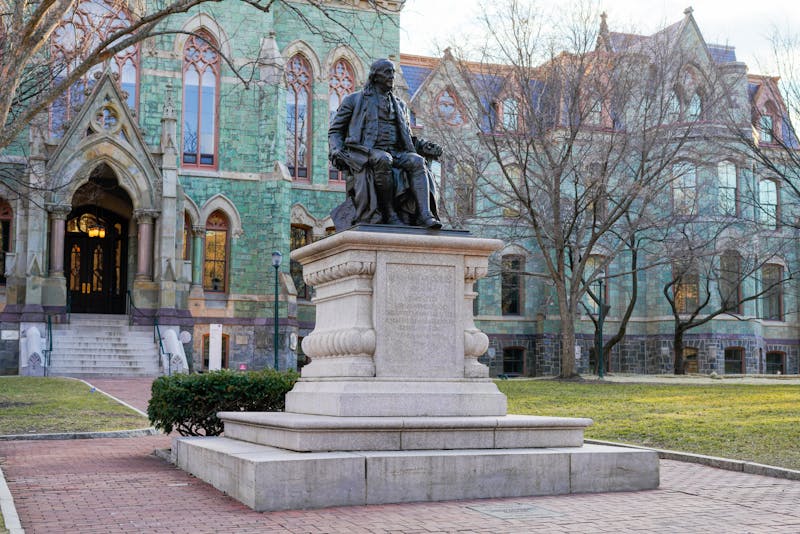
Every year, Penn Abroad sends more than 1,000 students to study overseas — but the sticker price of Penn tuition that all students pay can be tens of thousands of dollars more than what students at some other universities pay.
After learning that some students who studied abroad paid much more in tuition than those from some Ivy League institutions — even while participating in the same program —, the Undergraduate Assembly’s Academic Initiatives Committee decided to re-examine the cost of studying abroad.
Engineering senior Kaylin Raby studied at the University of Edinburgh during the 2017 spring semester. Raby, a first-generation college student, had never been abroad and wanted to go, since she came to Penn. But she said she was disappointed to discover that she was paying a significantly higher price than her Ivy League peers.
“When I was abroad, I learned about how other schools operated, the costs of tuition abroad and the admissions maintenance,” Raby said. “The price I was paying just did not add up.”
In comparison to the rest of the world, the cost of attending a university in the United States is demonstrably higher. According to the College Board, the average annual tuition and fees of attending a four-year nonprofit university like Penn is roughly $33,480 in the 2016-2017 academic year. Last year, Penn’s tuition and fees were $51,464, not including room and board. In 2017, the average annual tuition cost for a non-European student studying in Europe was roughly 8,600 euros approximately $10,160 based on current exchange rates.
A sample budget sheet on the Penn Abroad website estimates that Raby paid a total of roughly $34,111 for her semester in Edinburgh — $24,891 for tuition and administrative fees and an additional estimated $9,220 for flights and living expenses.
But according to the University of Edinburgh’s website, the full tuition for the 2017 spring semester was 7,650 pounds, or approximately $10,117 based on current exchange rates. Factoring in a conservative estimate of "upper range" living costs in Edinburgh and estimated program fees and travel costs provided by Penn Abroad, an average non-Penn student would pay a total of roughly $21,613 for the semester.
Based on these estimates, Raby paid nearly $12,500 more than the University of Edinburgh's suggested pricing.
Among the Ivy League universities, the costs of studying abroad vary. Some Ivy League schools such as Yale University require students to pay their semesters' tuition to the foreign university directly if it is a non-Yale program. On top of the tuition, students need to pay administrative costs, room and board, living expenses and other fees.
Most of Princeton University's study abroad programs require students to pay the tuition of the program they are attending. Only students enrolled in 11 specific programs are required to pay the full Princeton tuition while studying abroad.
Cornell University offers university-led programs that cost the same as a regular semester, but also offer approved programs that provide students with the option to pay the tuition and fees of the institution that they would attend.
Penn, Brown, Columbia and Darmouth are the four Ivy League schools that require students to pay full in-house tuition for all semester-long Penn Abroad programs.
According to Nigel Cossar, the director of Penn Abroad, paying the fixed Penn tuition comes with a variety of benefits. Students have access to an assortment of Penn resources back on campu such as Counseling and Psychological Services, consultations with their academic advisors, the Penn Online Library and financial aid. Cossar also emphasized that the ability to transfer academic credits was a fundamental reason for retaining in-house tuition costs.
“Penn actually awards Penn credit, and a lot of the Ivies don’t award in-house credit. They award transfer credit,” he said. “Many of Penn’s [schools] require students to take their major while abroad, so they are actually coming back with the equivalent of a Penn class.”
All courses taken overseas must be evaluated through Penn’s online External Course Approval Tool system by Penn staff who determine if they are worthy of credit. If they are, these courses taken overseas can count towards students' graduation requirements and affect their GPAs.
Cossar also stressed the intricacies of Penn’s bilateral student exchange programs as another major component of why students pay Penn tuition while studying abroad.
“We receive students coming in and they pay their school’s tuition at home, and likewise our students are paying our tuition,” said Cossar. “It’s a model that is seen as a common practice for exchange around the world.”
While the semester abroad offerings are the most popular option, Cossar also noted that Penn Abroad offers many other options – from Global Seminars to Summer Study Abroad – which vary in price.
The Undergraduate Assembly has not yet met with administrators to begin to assess the cost of study abroad, but the two UA members spearheading this project, Wharton junior Nile Nwogu and College sophomore Noah Kest, said their focus is to increase transparency.
“I think it’s more complex than simply lowering the costs of study abroad because that would mean that the money to finance these trips would have to come elsewhere,” said Nwogu. “We are basically trying to reassess the policy partnerships in general, and see where the real variables are.”
The Daily Pennsylvanian is an independent, student-run newspaper. Please consider making a donation to support the coverage that shapes the University. Your generosity ensures a future of strong journalism at Penn.
Donate






